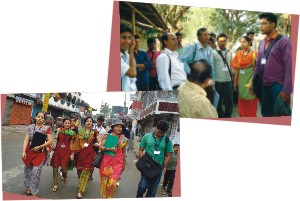Feature
Field Trip to Panchagarh
Muhammad Selim Hossain
 LIKE all other earth sciences and scientific disciplines, in Geography and Environment, direct observation is a basic and effective method of obtaining accurate information. During our fourth year of the honours degree in Geography and Environment at the University of Dhaka includes a course entitled “Land Use, Socio-economic and Environmental Studies”. This course trains us in field techniques and methods of rural and urban land use, survey, environmental analysis and socio-economic studies. At the end of the course, the students are assigned to submit a research-oriented report on land use, socio-economic and environmental studies of any geographic region. To prepare the report, every year the fourth year students of the department go on field trips to different parts of the country. This year, we went on a field trip between 17 to 21 March to Panchagarh to conduct a comprehensive study on land use, socio-economic and environmental studies in the Panchagarh town and Hafizbad Union of Panchagarh Sadar Upazila. The field trip was accomplished under the leadership of Professor Borhan and under the supervision of Professor Nurul Islam Nazem, the course teacher. LIKE all other earth sciences and scientific disciplines, in Geography and Environment, direct observation is a basic and effective method of obtaining accurate information. During our fourth year of the honours degree in Geography and Environment at the University of Dhaka includes a course entitled “Land Use, Socio-economic and Environmental Studies”. This course trains us in field techniques and methods of rural and urban land use, survey, environmental analysis and socio-economic studies. At the end of the course, the students are assigned to submit a research-oriented report on land use, socio-economic and environmental studies of any geographic region. To prepare the report, every year the fourth year students of the department go on field trips to different parts of the country. This year, we went on a field trip between 17 to 21 March to Panchagarh to conduct a comprehensive study on land use, socio-economic and environmental studies in the Panchagarh town and Hafizbad Union of Panchagarh Sadar Upazila. The field trip was accomplished under the leadership of Professor Borhan and under the supervision of Professor Nurul Islam Nazem, the course teacher.
Panchagarh is situated in the extreme north of the country and it is bounded on three sides by 288 kms of Indian border.
The district was formerly a sub-division of the Dinajpur district. It was upgraded to a zila in 1984. It is generally believed that there were Pancha (five) Garhs ( Jungles) in the present location of the zila, in consequence of which it was named Panchagarh. It was a thana under Jalpaiguri district of West Bengal during the British rule.
Physiographically, the land mass belongs to the Himalayan piedmont plain and so the soil is sandy, alluvial and bears close affinity with the soil of the old Himalayan basin. Historically, Panchagarh is also known to be the place of the Sonyasi Andolon and Fakir Andolon which occurred during 1763-1800. Also, the Tevaga Andolon originated from this district in 1946.
While conducting the study, we talked to different professionals including farmers, labourers, businessmen, school and college teachers, UP chairmen and members, local land surveyors, land owners and fellow people and tried to understand the different parameters of socio-economic condition from direct observation. Thus, we gathered plenty of experiences about their behavioural pattern, family, society, culture and the locality as a whole.
The inhabitants of the locality are very simple and sincere. They are mindful and responsible to their respective duties. Most of them are poor but honest and peace-loving. They hardly face unwanted social occurrences. Mutual co-operation and mutual understanding are considerably high and they seek immense pleasure in entertainment of others.
But the overall economic condition of the region is poor. Our study reveals that the difference between rich and poor is very extremely high. Some families have 200-300 bighas of arable land whereas a large number of people (about 33%) don't have any single plot of cultivable land. They cultivate the land of others. But the relation and understanding among the rich and the poor are highly satisfactory.
The inhabitants of Panchagarh have been extremely cooperative to our questions and enquiries. The district administration helped us in many ways including the providence of security for the entire length of time.
The simplicity, generosity and hospitality of the people have deeply impressed us. They are endowed with rare humane qualities that are worth learning.
(The writer is studying Geography and Environment at the University of Dhaka.)
|
